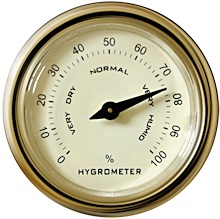
We of the Hydronic Realm often don't think too much about Indoor Air Quality, but that mindset is obsolete. We need to look at the Big Picture, not just the heating syste...

At a recent seminar someone asked a question about the widely accepted statement that forced-air heating system dry out the air as it passes through the heat exchanger.
Is this, in fact, true?
Well, the answer is that it depends. On What? I'm so glad you asked!
If by drying out the air you are referring to an actual reduction in the moisture content of the air, the answer is no.
In a nutshell, when we heat air, the amount of moisture contained in an air sample (as water vapor) remains the same. After all, if we heat water, what do we get? WATER VAPOR! So, if water vapor turns to water vapor there will be no change in the amount of water vapor in the air as it enters the heat exchanger because it's the same as the amount of water vapor in the air we're supplying to the occupied space. The actual amount of water vapor in an air sample is referred to as ABSOLUTE humidity, and we measure that in grains per pound of air, or as grains per some unit volume. It takes 7,000 grains of moisture to make 1 pound of water.
So far so good? Great!
So, what does happen to the air, and why do we get that feeling of dryness? And why does our furniture crack? And why do we get nosebleeds in our houses?
It's like this: Although the ABSOLUTE humidity does not change, the RELATIVE humidity does. And that requires some quick definitions. As I mentioned, we refer to the actual amount of moisture in an air sample as absolute humidity. Relative humidity is a bit more involved.
Relative humidity is the ratio of the amount of moisture in an air sample (multiplied by 100), divided by the air sample's ability to hold moisture (at saturation). For example, if an air sample has the ability to hold 80 grains of moisture but is only holding 40 grains of moisture, the relative humidity is (40/80) x 100 = 50%.
But what does this have to do with that dry feeling on my skin? Hang on; I'm getting there.
As we heat an air sample, the air's ability to hold moisture increases. Think of a kitchen sponge that is completely saturated with water. By saturated I mean that, if you placed one more drop of water on that sponge, it would drip from its bottom. It's completely saturated. Now, the amount of water in the sponge is, well, the amount of water in the sponge, and the total amount of water the sponge can hold is the same as the amount of water currently in the sponge because we decided that the sponge is completely saturated. The relative humidity is, therefore, 100%.
Now, wave your magic wand over the sponge to double its size. The waving of the wand doesn't increase the amount of water in the sponge, but only the size of the sponge and it's water-holding capability. Now the relative humidity of that sponge at that moment is only 50% because the sponge's ability to hold water has doubled, but the amount of water in the sponge remained the same.
We proceed.
As we heat air in a forced-air heating system, the air's ability to hold moisture increases, while the actual amount of moisture in the air sample remains the same. This causes the relative humidity to drop. And since the air can now hold more moisture, and our bodies contain a whole lot of moisture, the moisture from our bodies is released to the air. The same holds true with the moisture in our furniture, floors, paintings, etc.
So, we use humidifiers on forced-air heating systems not to replace the moisture that the heating system took away, but to increase the moisture content in an attempt to increase the relative humidity.
And here's something to think about: When air passes over the evaporator coil, have you ever noticed the condensate dripping from the coil? Of course you have! That's because, as I said before, as we heat air, its ability to hold moisture increases. And when we cool air, its ability to hold moisture decreases. That moisture is what you and I know to be condensate.
Get it?

We of the Hydronic Realm often don't think too much about Indoor Air Quality, but that mindset is obsolete. We need to look at the Big Picture, not just the heating syste...

Over my 37 year career in HVAC, I have been involved investigating many commercial and residential air quality problems. This article is intended to help homeowners to un...